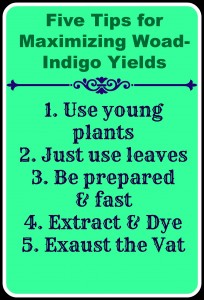I received an inquiry last week concerning dyeing with woad and woad indigo. Indigo is a unique natural dye with far more variables than other natural dyes. Natural indigo is soured from three families of plant, only one of which grows in the northern hemisphere. Woad indigo has an increased variability because woad is a biannual, and the indigo content changes between first and second year plants.
Five Tips for Maximizing Woad-Indigo Yields
- Use first year plants. The first year plants have the highest indigo potential. Thus the first year plants will produce more indigo pigment per kg than second year plants. Also, if you are utilizing woad that is behaving invasively, taking the first year plants will reduce the re-seed rate because they will not be there to flower in the second year.
- If using second year plants, use the leaves not the stalks. The stalks are fibrous and woody, much like a sunflower, and have very little dye potential. The second year leaves have a higher yield rate than the stalks do, nearly as good as first year leaves.
- Speed is everything with woad indigo extraction. If you are not fast, you will not get half the indigo you could have. The three major indigo precursors (read what gets turned into indigo in the extraction process) are Isatan A, Isatan B, and Indoxyl . The two Isatans are the precursors with the highest concentration in woad. However, these two precursors also start degrading as soon as the plant is picked. Absolute best extraction situation, you start heating the water before you go out to pick and finish the extraction within an hour of picking the leaves. This method gave me an indigo yield that was only a few grams smaller than the yield of Indian indigo.
- Dye directly from the extraction vat. Although the indigo will not be purified at this point, you will have the highest colour potential present and available. When I dried out my pigment, I also dyed with the water I strained off. Although the cloth originally came out green, a quick pH change to acidic shifted the colour back to blue. Depending on my situation, I had some waste-water vats that yielded a medium blue, as well as various shades of light and ice blue.
- Always, Always, Always exhaust the vat. Use washed fleece, roving, or extra wool yarn and pull all the colour you can from those indigo vats. With indigo it is essential that you utilize the “re-vatting” technique, permitting the indigo to oxidise so that you get the darkest shade and so utilize your vat to the highest extent. This is especially important if you are doing a direct extraction-reduction woad vat.
Back To You:
What Woad adventures have you been on? Have you used woad-indigo, or are you able to grow one of the other indigo plants? I would love to hear from you, leave a comment.